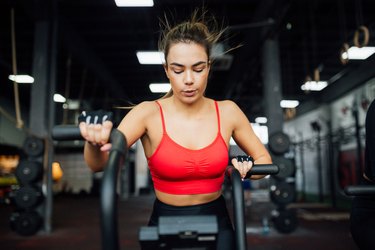
A tough cycling session works your heart , lungs and major muscle groups in your lower body. Although you use the abdominal muscles for power and stabilization, bike riding for abs isn't the most direct way to work your six-pack. Exercises off the bike are much more effective.
Bike Riding for Abs
Video of the Day
The main muscle in your abdomen is the rectus abdominis. It is one single muscle that runs from the ribs to the pelvis and is intersected horizontally with tendons creating a rippled appearance — the illustrious six-pack. Those tendons also serve the purpose of essentially binding the entire rectus abdominis to the abdominal wall, explains the American Council on Exercise.
Video of the Day
This promotes an equal distribution of force across the muscle, regardless of whether the top or the bottom part is doing more work. When you're working your abs, you work the entire muscle, both the upper and lower part.
The rectus abdominis and the other ab muscles — the transverse abdominis and obliques — play a crucial role in bike riding. As part of the core, which also includes the lower back and hips, the abdominal muscles help stabilize the body, protect the spine and transfer forces between the upper and lower body, according to Nationwide Children's Hospital.
When you're riding a bike, your abs help to keep you upright and to hold your upper body in the right position, according to Harvard Health Publishing. When you're riding outdoors, on a bike that isn't stationary and travels over unstable surfaces, your abs have to work even harder to stabilize the body. And whether outdoors or in, your abs play a role in force production, even though it's the big muscles in your legs — glutes, quadriceps and hamstrings — that do the bulk of the work.
Make Those Abs Work
Theoretically, the harder you work the harder all your muscles, including your abs, have to work. Bumping up your speed or riding up hills — simulated hills in the case of a stationary bike — will provide more of a challenge for your abdominal muscles. Different body positions, such as standing upright or leaning forward over the handlebars, creates more instability, meaning more work for the core.
In addition, riding on more unstable surfaces, such as off-road, will require more work from your core muscles to stabilize your body. If you are riding outdoors, on-road or off, make sure you have the proper safety gear and know the rules of the road or trail.
There may be another way to make the lower portion of the abs work slightly harder — or at least feel like they are working harder. According to the American Council on Exercise, when the hips move closer to the ribs in a fixed position, the lower abs will work harder than the upper abs. If you are on a stationary bike, keep the ribs steady and focus on the movement of drawing the legs up toward the ribs with each pedal stroke.
Exercises Off the Bike
A better bet for strengthening your abs is to to do core work off the bike. Harvard Health Publishing recommends doing core exercises two or three times per week. You can do them as part of your total-body strength training routine.
One of the best ab exercises for cycling is the plank hold, according to British Cycling. You can also add in the shin balance leg lowering and mountain skater exercises recommended by the American Council on Exercise for overall abdominal strength.
Move 1: Plank
- Start on all fours with your shoulders over your wrists.
- Tuck your toes and lift your knees off the floor into a push-up position.
- Keep your hips in line with your shoulders and draw your abdominal muscles in toward your spine.
- Hold for 30 seconds to start and work your way up to one minute.
- Rest for 30 seconds and repeat two more times.
Move 2: Shin Balance Leg Lowering
- Lie on your back with your legs lifted, forming 90-degree angles at your hips and knees.
- Place a small stability ball on top of your shins.
- Slowly extend your legs out, keeping the ball balanced. Keep your lower back in contact with the floor.
- Draw your legs back into the starting position without dropping the ball.
- Repeat for two sets of 10 to 15 reps.
Move 3: Mountain Skater
- Start on all fours. Then lift the hips up so they are higher than your shoulders.
- Bend both knees slightly and contract your abdominal muscles.
- Draw your right knee to your left elbow; then bring it back to the start.
- Draw your left knee to your right elbow and then return to the start.
- Repeat 10 to 20 times on each side.
- American Council on Exercise: "Can You Train Upper and Lower Abs Separately?"
- Nationwide Children's Hospital: "Core Stability: What Is It and Why Is It Important?"
- Harvard Health Publishing: "The Top 5 Benefits of Cycling"
- Harvard Health Publishing: "How to Add Core Exercises to Your Workout Routine"
- British Cycling: "Strength Exercises for Cyclists"
- American Council on Exercise: "6 Exercises to Stimulate Your Abs"